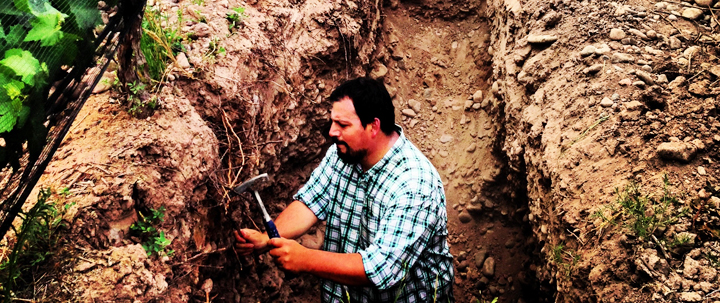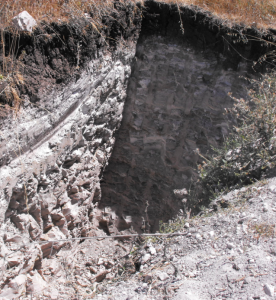Terroir is a unique place modulated by geology and weather, and the men who work with all these elements… A place would never be a terroir without the men because if nobody’s playing the tune, there’s no music sound. ~Pedro Parras
Pedro Parras is one of the few terroir specialists in the world. He received a Master’s Degree in Precision Agriculture and a Ph.D. in Terroir from the National Institute of Agronomic Research in France. He studied in Burgundy and Bordeaux with French experts such as Michel Claude Girard and Pierre Becheler, before returning to home country Chile. He has since helped south America shape its terroir.
Many winemakers claim their wines are from a unique terroir, but whether you could taste it in the wine or not, is another question. Here, Pedro breaks down the elements of terroir and gives a framework to help understand the concept.
Climate
There are two major climates that contribute to different terroirs:
Sunny, stressing climate: French call it “solaire” climate – usually too much sun, where vines work very hard, and need lots of water. In this climate, wine’s acidity goes down, pH level goes up, and the wine on the palate is more flat, soft and round, with more alcohol. Napa, some of the Bordeaux today, Chateauneuf-du-pape are classic “solaire wine”.
Cloudy, relaxing climate: cloudy in the beginning of the growing cycle (May to mid-July), then sunny, and cloudy again in the end of the growing season (September, October). In cloudy climate, wine’s acidity is much higher, pH much lower, the wine usually lives longer. On the palate, the sensation is tension (especially in the back of the jowl), and lively energy. Classic cloudy wine include Burgundy, Alsace, Piedmonte, some Tuscany, Brunello, La Rioja etc.
Soil
Rock in the soil plays an important role. Soil without rock usually contains higher fertility and higher water holding capacity. The roots in this soil are happily fed by the superficial layer, what Pedro calls “the McDonald’s part”, which is not healthy for the vines. 90% of the wine from this type of soil are simple, over-riped but “green” – too much alcohol, and because soil is so potent that the grapes never get the maturity in the tannins. “You find that a lot in Napa, Chile, Mendoza, and Australia,” said Pedro.
Soil with rock is where it gets interesting. Based on research, Pedro concluded that 90% of great wine in the world come from four types of old rock: limestone, granite, schist and volcanic. Determine how advanced the rock has transformed into soil is the key – has it alternated into a mix of soil-rock texture? Or like granite it’s still very hard for the roots to get in? “Burgundy is all about that – the stage of alteration of limestone in different appellations.” There’s also newer rock like gravels in Bordeaux and Chateauneuf-du-pape, which were formed in the later part of the evolution.
How does the rock structure? What’s the direction of its grain?… These all affect the way the roots absorb water and minerals.
Drill down to some advanced intelligence could pay off. “For example, Haut-Medoc in Bordeaux is famous for gravels soil, but there are six types of alluvial terraces, formed in different moments in the past. A wine could come from the same type of terrace as a Grand Cru Classe Chateau does, even though it’s not classified as one… That means you could pay $30 rather than $200 for a fantastic wine.”
Men
Terroir is like music notes, and winemakers are like musicians. One musician plays one way, another might play the same notes differently. It’s hard to say which interpretation is the best – even if you love one and hate the other. They also have different attitude about terroir. “Some winemakers would say: ‘Bring me the grapes, I don’t care from where and I’ll make the best wine.’ Other may say: ‘I need to get grapes from a great terroir to make a great wine.’”
Many winemakers stress that their wine is from limestone, but you can’t taste the chalky character in their wine. Then again you could always count on a St Joseph from J.L. Chave to have that granite minerality telling its terroir.
Taste the Terroir
Terroir is just a word, until you taste it in the wine. End of the day, it’s about wine.
For Pedro, he always tries to find a signature in wine that comes from rock. “I like to look for ‘schist wine’ in regions like Priorat, Douro and Cote Rotie – because I love that style. I also love blind tasting by rock. Two weeks ago I had dinner with Josh Reynolds, a fantastic wine writer with tremendous knowledge. We were buying wines in the restaurant just to talk about rock! Josh understands very well about terroir, not because someone shows it to him, but because he finds ways to explore and taste… If you go to Gevery Chambertin in Burgundy, nobody would show you the soil and explain his terroir to you.”
New World terroir
Pedro doesn’t think New World need to follow the way Old World set up its appellations, because it’s too restricted. “We should learn about its good and bad. With the current appellations and some freedom, the New World would come up a system that make sense for them. And whoever can make a difference by showing significant characters that reflect the terroir, would stand out.”
Reaching to an identity requires clarity. Many New World winery owners learn from the information established in Napa and Australia 25 years ago, meanwhile hire French or Italian consultants, who might have a completely Old World approach, to make the wine… Wine fashion is also an obstacle for New World. “Many like dark fruit flavor so they tend to over-ripe the grapes, because dark fruit is also more recognizable for regular drinkers. But it’s like perfume, you love a perfume and wear it as a personal signature, then you go out and realize that everybody’s wearing the same perfume! Dark fruit is so intense, and it can easily masks the beautiful complexity the terroir could offer. What about the flower, the acid fruit, or the forest aroma? Too much dark fruit and alcohol, in my opinion, is erasing the terroir. Meanwhile people who make this type of wine would tell you, that they respect terroir.”
“On the other hand, it took us 900 years to learn that wines from Gevrey Chambertin and Morey St Denis are different. Now, with so much information and ideas available to us, 900 years could be 50 years. Back in 2007 when I started to work on a project in Mendoza Argentina, there were only two areas recognized for their different terroirs. In merely six years, they’ve now reached a general maturity to split the locality into seven areas from which you’d find very good Malbecs.”
A terroir specialist in practice
“Establishing a new vineyard could be very expensive, and you don’t want to make mistakes from the get-go. Clients would have me come over and look at the property, the soil, and take samples… I’d try to understand weather pattern and many other aspects, talk to people who live there… After further understand all factors I’d design a site, come up with an acreage plan indicating top terroir, okay terroir and areas not to plant anything at all, as well as varietals that we could plant or shouldn’t plant…”
Chilean terroir
Modern Chile has been strongly influenced by French, and Cabernet is the most planted varietal. “But we’re not in Bordeaux, so we can’t make Bordeaux. I think so far we don’t know how to play our music, and we’re just copying. You can’t ask an 8-year-old kid to be smarter so he can go to college at 10. But at least we started to ask ourselves questions and try to find our own way. Some winemakers are doing a great job already. Chile will have a place in the market when people who buy Chilean wine recognize that Chile is doing something original.”
Chile is a mountain country and has plenty of great terroirs formed by earthquakes and fractures; as well as its span of various types of climates. “The main question for Chile is ‘What do you want to do?’ which is always the hardest question. Today it puts more focus on cheap wine, in the near future, it would produce better wine with great value and regional typicity, and elevate to medium-priced market.”
Making wine from terroir he believes in
Besides terroir consulting career, Pedro also makes wine. He is involved in two projects. “One is a high-profile joint venture called Aristos, a partnership between a Chilean French, myself and Louis-Michel from La Romanee in Burgundy. We started the vineyard in 2007, and the result has already been fantastic.” The Aristos Chardonnay is not only the very first Chilean wine got 100 point from Decanter, it was also the first non-French Chardonnay that achieved 100 points.
The other project is more personal for Pedro. Clos des Fous – the hill of the crazy guys. “We started in 2008 at a site with crazy terroir, everyone was telling us that it’s not gonna work. But we’re so crazy that we did it anyway. The soil are mainly limestone, granite, schists and volcanic. We planted very old Pinot Noir vines from ancient Chile. So far the result has been amazing. It’d be hard to find because we only make 10,000 cases, but it’s a beautiful and funny wine that’s worth seeking out.”
On China
“I work with a very good friend, an Italian enologist Alberto Antonini, who was contacted by a Chinese enterprise who wants to develop Chinese terroir. If the project is confirmed, I’d be working with him in China. I’ve never been to China, but the principles of constructing terroir are similar: ‘Where can I find certain climate? Where can I find certain geology?’ If we could find a great combination of the two, then it’s a great start (to produce better wines in China). Chinese are smart and learn very fast, they will find their way soon. Until then, Chinese terroir will remain buried.”
Read this!
Pedro highly recommeds Great Wine Terroir by Jacques Fanet. “Jacques takes you around the world and explain the terroir differences between regions. It’s an easy read that would help you understand wine regions in a deeper way.”

